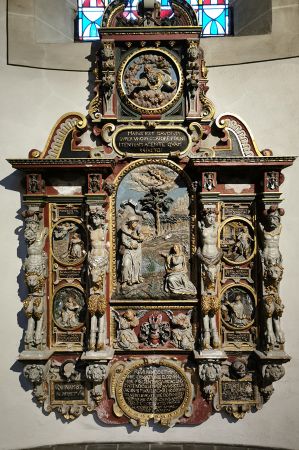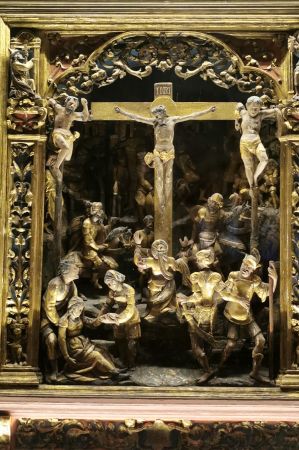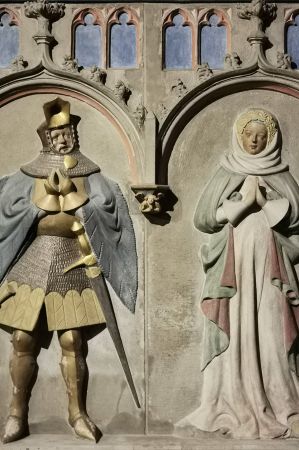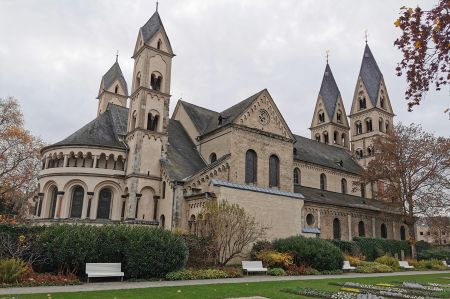The Basilica of St. Castor at the Deutsches Eck in Koblenz
- Written by Portal Editor
The Basilica of St. Castor is located in the middle of a green area just behind the Deutsches Eck, probably the most famous sight in Koblenz, apart from where the Moselle meets the Rhine.
Between the church and today's headland at the confluence of the Rhine and Moselle is the former command of the Teutonic Order, today also the valley station of the cable car (Rheinseilbahn) up to Ehrenbreitstein Fortress (we have already reported about it). The entire area was part of the event area for the Federal Garden Show 2011 and was completely redesigned for this purpose.
Roman fort at the Basilica of St. Castor in Koblenz
 At the site of today's Kastorkirche, which was built in an area free of flooding, remains of settlements can be traced back to prehistoric times. The Romans built a first fort in this area at the time of Emperor Augustus (27 BC–14 AD), the first evidence of which was found in November 2008, when an ancient ditch was discovered during construction work for the 2011 Federal Garden Show.
At the site of today's Kastorkirche, which was built in an area free of flooding, remains of settlements can be traced back to prehistoric times. The Romans built a first fort in this area at the time of Emperor Augustus (27 BC–14 AD), the first evidence of which was found in November 2008, when an ancient ditch was discovered during construction work for the 2011 Federal Garden Show.
The four metres wide and still 2.5-meter-deep ditch of the 100 by 100-meter large fort is proof of the early Roman settlement of Koblenz, which had previously been searched for 150 years in vain in the area of the old town. After the fort was abandoned, a Gallo-Roman ambulatory temple was built in the area of today's chancel of the church, which existed from the late 1st to the 4th century. In Frankish times around 600, a cemetery was laid out on the area of the temple, which was used until the middle of the 12th century.
Koblenz was also a Frankish royal court
 A first building of the Kastorkirche was built from 817 to 836 under the Archbishop of Trier Hetti with the support of Emperor Ludwig the Pious in front of the gates of the city of Confluentes and consecrated on November 12, 836. Since there was a Franconian royal court in Koblenz, Ludwig was the builder and the church was a Carolingian church. However, Ludwig only came to Koblenz after the church had been consecrated.
A first building of the Kastorkirche was built from 817 to 836 under the Archbishop of Trier Hetti with the support of Emperor Ludwig the Pious in front of the gates of the city of Confluentes and consecrated on November 12, 836. Since there was a Franconian royal court in Koblenz, Ludwig was the builder and the church was a Carolingian church. However, Ludwig only came to Koblenz after the church had been consecrated.
This increases the importance of the archbishop for church building, especially since the church was located outside the city of Koblenz until the 13th century. The relics of St. Castor were transferred from the collegiate church of St. Castor in Karden on the Moselle to Koblenz for consecration. As a saint of the city of Koblenz, Ludwig's alleged daughter Rizza was venerated in the church, whose reliquary is still in the church.
The church building belonged to the so-called Kastorstift
 The first Castor church of the 9th century was a Carolingian hall building with the width of today's nave. A vestibule adjoined it to the west, along with a transept and a directly terminating semi-circular apse to the east. A ring corridor led around them from the outside. At its apex was an intermediate building that reached to a rotunda in the east. This outer crypt was probably related to the imperial foundation. The church building belonged to the so-called Kastorstift (collegiate monastery of St. Kastor), in which priests lived in a monastery-like community.
The first Castor church of the 9th century was a Carolingian hall building with the width of today's nave. A vestibule adjoined it to the west, along with a transept and a directly terminating semi-circular apse to the east. A ring corridor led around them from the outside. At its apex was an intermediate building that reached to a rotunda in the east. This outer crypt was probably related to the imperial foundation. The church building belonged to the so-called Kastorstift (collegiate monastery of St. Kastor), in which priests lived in a monastery-like community.
Twin tower facade, transept, choir and an apse
 The Basilica of St. Castor is a three-nave vaulted basilica with a double-tower facade, transept, choir and an apse flanked by two smaller towers.
The Basilica of St. Castor is a three-nave vaulted basilica with a double-tower facade, transept, choir and an apse flanked by two smaller towers.
The detached church building made of light-coloured tuff lies in the middle of a green area.
The towers, articulated with pilasters, have steep gables and diamond-shaped roofs.
The west portal was created by Matthias Schmitz in 1859 and the figurative tympanum above it by Joseph Fuchs in 1866.
The sculptures represent, from left to right, Saint Ludovicus, Blessed Rizza, Mary and Child, Saint Goar and Archbishop Hetti.
Above the portal in a niche is a figure of Saint Castor by Gottfried Götting.
Symbol of the Holy Virgin Mary
Next highlight - Deutsches Eck!
Please read as well:
Archaeological Excavations of the settlement of Siculi in 2015
